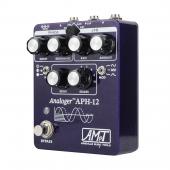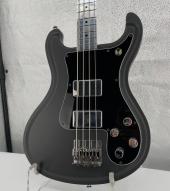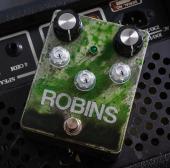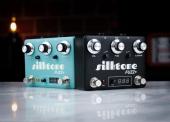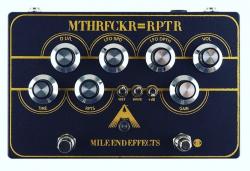Mile End Effects MTHRFCKR=RPTR Cassette Tape Delay/PreAmp
Brands:
This pedal is where Mile End finally landed after years of appreciating and collecting malfunctioning tape machines, trying to find units with JUST the right amount of low fidelity wobble, hiss and saturation (usually right before the machine becomes entirely unusable).
The mthrfckr=rptr is at its core a delay pedal aimed at capturing the beautifully haunted artifacts found in poor quality or degraded magnetic tape and dedicated to the unstable mechanical nuances of a malfunctioning capstan motor. Random, non-cyclical LFO modulation is what mimics the very inconsistent modulation of physical tape being pushed across magnetic tape heads by a DC motor.
In addition, a switchable PreAmp circuit allows you to drive the mthrfckr=rptr into a fizzy, blown-out, tape saturated overdrive. I have been heavily inspired by this sound and my hope is to inspire others who have been moved by the sound of these old malfunctioning tape machines and offer the tools to recreate it without having to stumble upon the small window of opportunity somewhere between functionality and ruination.
Controls;
D. LVL- Mixes the amount of effected signal verses dry signal. (Clockwise more, counter-clockwise less)
TIME- Sets the speed of the echo (Clockwise fast, counter-clockwise slow)
RPTS- Sets the number of echo repeats aka the feedback (clockwise more, counter-clockwise less)
LFO DPTH- sets the amount of random, non-cyclical LFO modulation (clockwise more, counter-clockwise less)
LFO SPEED- Sets the speed of the LFO modulation (clockwise slow, counter-clockwise fast)
Volume- Overall output volume of the PreAmp
Gain- How hard you wish to distort the PreAmp. The higher your input signal, the more this PreAmp will blow out into a fizzy, saturated mess. Highly recommended to put your favourite fuzz pedal or boost in front of it and see what kinds of noise you can make. It also sounds especially good with a fat bass synth.
WET- Removes your dry, unaffected signal from the delay line. This can be especially useful with the repeats turned off to send master tracks through as a recording technique, adding a very lo-fi quality to any recording (Sometimes its nice to record in protools and then send your master tracks to a cassette tape, trust me!) OR put the wet signal on a bus track to mix in and out of for live sound applications.
WAVE- Choose between random, non-cyclical square wave or sine wave LFO modulation
-The Sine wave setting adds a subtle seasick quality to the delay. Almost as if you had left a vinyl record in the sun on a hot day or have a tape machine whose DC motor is unhealthy, creating very subtle changes in the tape speed.
-The Square wave setting at fast speeds can flutter like a poorly tracked VHS tape or wrinkled audio tape and at slower speeds will mimic the sound of a tape machine in need of a good cleaning. As tape passes over dirty mechanics in the machine, it will sometimes get stuck very briefly and as the motor struggles to pull the tape back to speed, you will hear a whiplashing effect as the tape frees itself from the filthy hands of its captor (or capstan!).
+dB- engages the Cassette Tape PreAmp
Momentary Switch- allows the delay repeats to self oscillate or ‘warp’
-
STANDARD 2.1mm CENTRE-NEGATIVE 9vDC POWER SUPPLY. This pedal requires 100mA.

